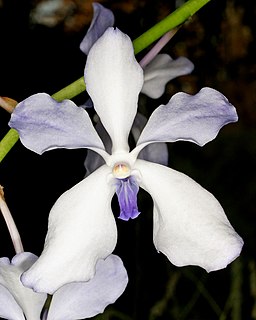
Vanda, abbreviated in the horticultural trade as V., is a genus in the orchid family, Orchidaceae. There are about 80 species, and the genus is commonly cultivated for the marketplace. This genus and its allies are considered to be among the most specifically adapted of all orchids within the Orchidaceae. The genus is highly prized in horticulture for its showy, fragrant, long-lasting, and intensely colorful flowers. Vanda species are widespread across East Asia, Southeast Asia, and New Guinea, with a few species extending into Queensland and some of the islands of the western Pacific.

Dendrobium is a genus of mostly epiphytic and lithophytic orchids in the family Orchidaceae. It is a very large genus, containing more than 1,800 species that are found in diverse habitats throughout much of south, east and southeast Asia, including China, Japan, India, the Philippines, Indonesia, Australia, New Guinea, Vietnam and many of the islands of the Pacific. Orchids in this genus have roots that creep over the surface of trees or rocks, rarely having their roots in soil. Up to six leaves develop in a tuft at the tip of a shoot and from one to a large number of flowers are arranged along an unbranched flowering stem. Several attempts have been made to separate Dendrobium into smaller genera, but most have not been accepted by the World Checklist of Selected Plant Families.

The Singapore Botanic Gardens is a 162-year-old tropical garden located at the fringe of Singapore's Orchard Road shopping district. It is one of three gardens, and the only tropical garden, to be honoured as a UNESCO World Heritage Site. The Botanic Gardens has been ranked Asia's top park attraction since 2013, by TripAdvisor Travellers' Choice Awards. It was declared the inaugural Garden of the Year, International Garden Tourism Awards in 2012, and received Michelin's three-star rating in 2008.
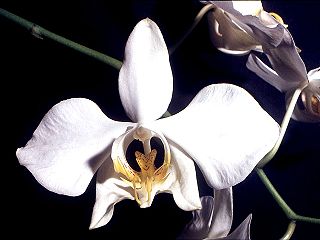
PhalaenopsisBlume (1825), commonly known as moth orchids, is a genus of about seventy species of plants in the family Orchidaceae. Orchids in this genus are monopodial epiphytes or lithophytes with long, coarse roots, short, leafy stems and long-lasting, flat flowers arranged in a flowering stem that often branches near the end. Orchids in this genus are native to India, Taiwan, China, Southeast Asia, New Guinea and Australia with the majority in Indonesia and the Philippines.

Grammatophyllum speciosum, also called giant orchid, tiger orchid, sugar cane orchid or queen of the orchids, is a species of orchid native to Indonesia. It is listed by the Guinness Book of World Records as the world's tallest orchid, with specimens recorded up to 7.62 metres (25 ft) in height.

Dendrobium crumenatum, commonly called pigeon orchid, or 木石斛 is an epiphytic orchid in the family Orchidaceae and is native to Asia, Southeast Asia, New Guinea and Christmas Island. It has two rows on leaves along its pseudobulb and relatively large but short-lived, strongly scented white flowers. It usually grows in exposed positions in lowland rainforest and coastal scrub.

Thomas Lobb (1817–1894) was a British botanist and, along with his older brother, William Lobb, collected plants for the plant nursery Veitch.
Richard Eric Holttum was an English botanist and author.

Rhynchostylis retusa is an orchid, belonging to the Vanda alliance. The inflorescence is a pendant raceme, consisting of more than 100 pink-spotted white flowers. The plant has a short, stout, creeping stem carrying up to 12, curved, fleshy, deeply channeled, keeled, retuse apically leaves and blooms on an axillary pendant to 60 cm (24 in) long, racemose, densely flowered, cylindrical inflorescence that occurs in the winter and early spring. It is famous for its use as an hair-ornament worn by Assamese women during folk dance Bihu on the onset of spring.

Dendrobium bigibbum, commonly known as the Cooktown orchid or mauve butterfly orchid, is an epiphytic or lithophytic orchid in the family Orchidaceae. It has cylindrical pseudobulbs, each with between three and five green or purplish leaves and arching flowering stems with up to twenty, usually lilac-purple flowers. It occurs in tropical North Queensland, Australia and New Guinea.
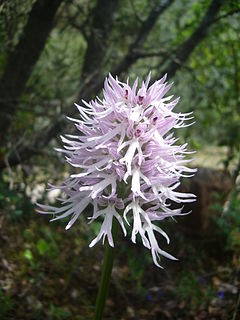
Orchis italica, commonly known as the naked man orchid or the Italian orchid, is a species of orchid native to the Mediterranean. It gets its common name from the lobed lip (labellum) of each flower which mimics the general shape of a naked man. In Italy, it is believed that the consumption of the plant is conducive to virility. It prefers partial shade and low nutrient soil and flowers in April. O. italica grows up to 50 centimetres (20 in) in height, with bright pink, densely clustered flowers. They are found commonly and widespread in the Mediterranean in large clusters.

Papilionanthe Miss Joaquim, also known as Vanda Miss Joaquim, the Singapore orchid, or the Princess Aloha orchid, is a hybrid orchid that is the national flower of Singapore. For its resilience and year-round blooming quality, it was chosen on 15 April 1981 to represent Singapore's uniqueness and hybrid culture.
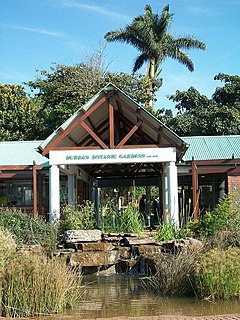
The Durban Botanic Gardens is situated in the city of Durban, KwaZulu-Natal, South Africa. It is Durban's oldest public institution and Africa's oldest surviving botanical gardens. The gardens cover an area of 15 hectares in a subtropical climate.
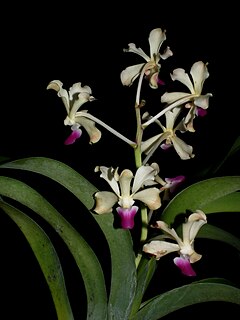
Vanda ustii, the University of Santo Tomas' vanda, is an orchid species found only in the Philippines. It is named after the University of Santo Tomas or U.S.T.

Bromheadia finlaysoniana, commonly known as the pale reed orchid and as Bromheadia pulchra in Australia, is a plant in the orchid family and is native to areas from Indochina to northern Australia. It is a terrestrial orchid with a tough upright, stem and stiffly spreading, elliptic to egg-shaped leaves. There is a long flowering stem with a short zig-zag section near the end where single flowers open in succession. The flowers are white with a yellow labellum.
Warren Delabere Barnes was a British colonial administrator.
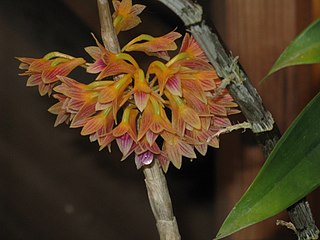
Dendrobium × usitae, Usita's dendrobium, is a species of epiphytic orchid endemic to the Philippines. It is a natural hybrid between D. bullenianum and D. goldschmidtianum and can be easily distinguished from both species by its purplish orange flower. The specific epithet honors Villamor T. Usita of Quezon City, who discovered the species from Calayan, one of the five major islands of Babuyan archipelago. In its native habitat, the plant grows hanging on trees at an elevation of 500 to 700 meters above sea level alongside with its parent species. The pendulous stem of D. × usitae can reach a length of 60 centimeters.

Phalaenopsis × intermedia, the intermediate phalaenopsis, is a natural occurring hybrid of epiphytic orchid endemic and most commonly seen orchid species in the Philippines. A progeny of Phalaenopsis aphrodite and P. equestris, this orchid thrives in the heat of the lowlands, in primary and secondary forests at an altitude of sea level to 300 meters where it blooms all year round. Unlike other natural hybrid within the genus, P. × intermedia seldom found growing within the range of its parent species and has formed sexually reproducing, stable populations in the wild. All red-lipped Phalaenopsis have pedigrees that can be traced back to this orchid.

Goodyera rubicunda, commonly known as the giant jewel orchid, is a species of orchid that is native to parts of India, Asia, Southeast Asia, New Guinea, Queensland and some Pacific Islands where it grows in damp forest and rainforest. It has between three and six large, egg-shaped leaves and up to ten dull pink and white resupinate flowers that are hairy on the outside.
Johan Hermans is a British botanist specialising in orchids, and an Honorary Research Associate of Royal Botanic Gardens, Kew. His The Orchids of Madagascar, described as "a now classic work", was published in a second edition in 2007.




















